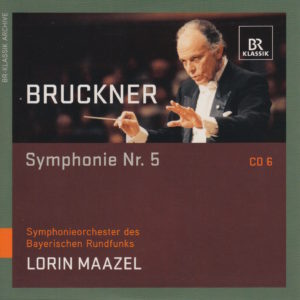 This morning’s conductor of Anton Bruckner’s Symphony No. 5 in B-Flat Major (WAB 105) – nicknamed “Tragic,” “Church of Faith,” or “Pizzicato” symphony (for reasons I’m still discovering), is American Lorin Maazel (1930-2014).
This morning’s conductor of Anton Bruckner’s Symphony No. 5 in B-Flat Major (WAB 105) – nicknamed “Tragic,” “Church of Faith,” or “Pizzicato” symphony (for reasons I’m still discovering), is American Lorin Maazel (1930-2014).
I had never heard of Maazel prior to the start of my 144-day project 73 days ago.
I’m not going to lie. I have not been a fan of Maazel’s.
I just hope this recording is different. But pretend I didn’t type that. (Keep an open mind. Keep an open mind. Keep…)
I first encountered Maestro Maazel on Day 9.
Then, Day 25.
Then Day 41.
And, most recently, Day 57.
First, just the facts, Ma’am:
 Bruckner’s Symphony No. 5 in B-Flat Major (WAB 105) composed in 1875-1876
Bruckner’s Symphony No. 5 in B-Flat Major (WAB 105) composed in 1875-1876
Lorin Maazel conducts
Maazel used the “1875-1878 version, edition Nowak”
Symphonieorchester des Bayerischen Rundfunks plays
The symphony clocks in at 79:56
This was recorded in Munich, Germany, in 1999
Maazel was 69 when he conducted it
Bruckner was 51 when he finished composing it
This recording was released on the BR Klassic label
According to its entry on Wikipedia, the version listed on the CD sleeve doesn’t exist. Not exactly, anyway. There’s no “1875-1878 version” listed anywhere. But I’m guessing the record label meant the 1878 version, about which the Wiki reads,
1878 version
This is the version normally performed. It exists in editions by Robert Haas (published 1935) and Leopold Nowak (published 1951) which are almost identical.
Bruckner wrote his symphonies in four parts. The time breakdown of this one (Symphony No. 5 in B Flat Major, 1875-1878 version, edition Nowak), from this particular conductor (Maazel) and this particular orchestra (Symphonieorchester des Bayerischen Rundfunks) is as follows:
I. Introduction (Adagio) — Allegro. B-flat major……………………………23:09
II. Adagio. Sehr langsam. (Very slowly) D minor……………………………15:05
III. Scherzo. Molto vivace D minor…………………………………………………14:33
IV. Finale (Adagio) — Allegro moderato. B-flat major…………………..27:07
Total running time: 79:56
And now for my subjective assessment:
My Rating:
Recording quality: 3 (ambient sounds, plus the brass instruments sound brassy and loud)
Overall musicianship: 4
CD liner notes: 3 (short – but interesting – essays on Bruckner, Maazel, and the orchestra, translated into German and English; however, virtually nothing about the recordings – like when? where? what year? that information is on the CD sleeve)
How does this make me feel: 3 (if I could give it 3.5, I would)
Well, I didn’t hate this.
But I think I can pin down precisely what it is about this recording that didn’t resonate with me: the orchestra seems screechy. Yeah. That’s probably close to what this feels like. The strings are piercing, screechy. And the brass is irritating. Listening to this makes me wince.
That, plus the ambient sounds (I swear I can hear stools squeak as musicians shift in them) make me forget I’m listening to a collection of instruments; rather than a symphony as a whole.
Does that make sense?
It seems that the instruments in this recording, more often than not, call attention to themselves.
Maazel’s interpretation of Bruckner’s Fifth has a lot going for it. If it’s possible, I think I liked it more than Jochum’s from the “white box” on Day 70. Movement III (Scherzo) seems to lend itself to an orchestra that sounds too-loud, too-brassy, too-piercing. The composition, itself, has that feel to it. Brash.
So this recording of Maestro Maazel’s interpretation is not totally awful. It has its moments.
Like, for example, trying to figure out the sound at 5:48 of Movement III. It sounds like a sneeze. But it could be a musician hitting something as percussion. Whatever it is, I haven’t heard that in any other recording of Bruckner’s Fifth to which I’ve listened (intently) for the past nine days. It’s new to me.
This too-screechy, too-loud, too-brash quality doesn’t make for an enjoyable Finale (Movement IV), however. Especially toward the end when all of the instruments seem to – in my ears, anyway – bury the needle in the red zone.
Oh, I’m not talking about poor mastering or poor recording or poor anything like that. I’m talking about the total sound rendering the whole thing indistinct. Like, “Whoa, dude. Too much.”
 Then comes the applause at the end, which still grates my cheese.
Then comes the applause at the end, which still grates my cheese.
I dislike applause in a Classical recording.
I loved it on The Beatles At the Hollywood Bowl Live. Because that applause sounded like a jet engine. The screaming, shouting, clapping fans in the audience at the Bowl was, in large part, the reason for the electricity of the recording. I’ve never heard anything like that album (and I really do mean “album” because I owned the vinyl LP back in the day).
I also loved it on the KISS Alive! album, partly because I had just seen KISS some seven days prior to the release of that album. I was still flying high from adrenaline. And KISS was my favorite band at the time.
 But a Beatles concert at the height of Beatlemania or KISS at the start of world-wide fame and fortune is not Symphonieorchester des Bayerischen Rundfunks conducted by Lorin Maazel.
But a Beatles concert at the height of Beatlemania or KISS at the start of world-wide fame and fortune is not Symphonieorchester des Bayerischen Rundfunks conducted by Lorin Maazel.
So the applause – especially when I don’t think the performance warrants it – only irritates me.
But, that’s just me.
Your mileage may vary.
